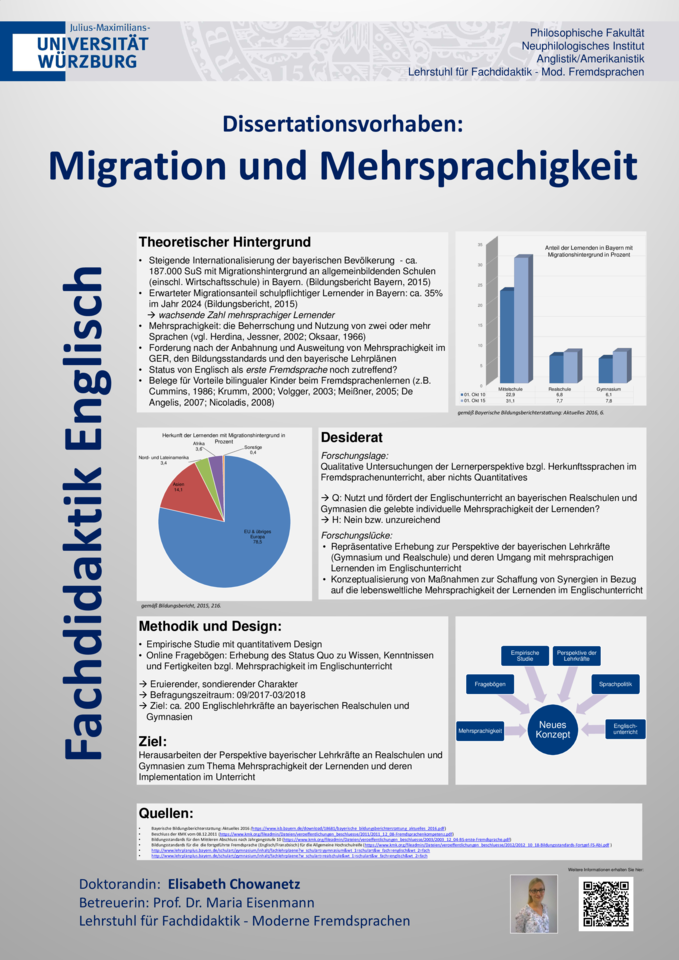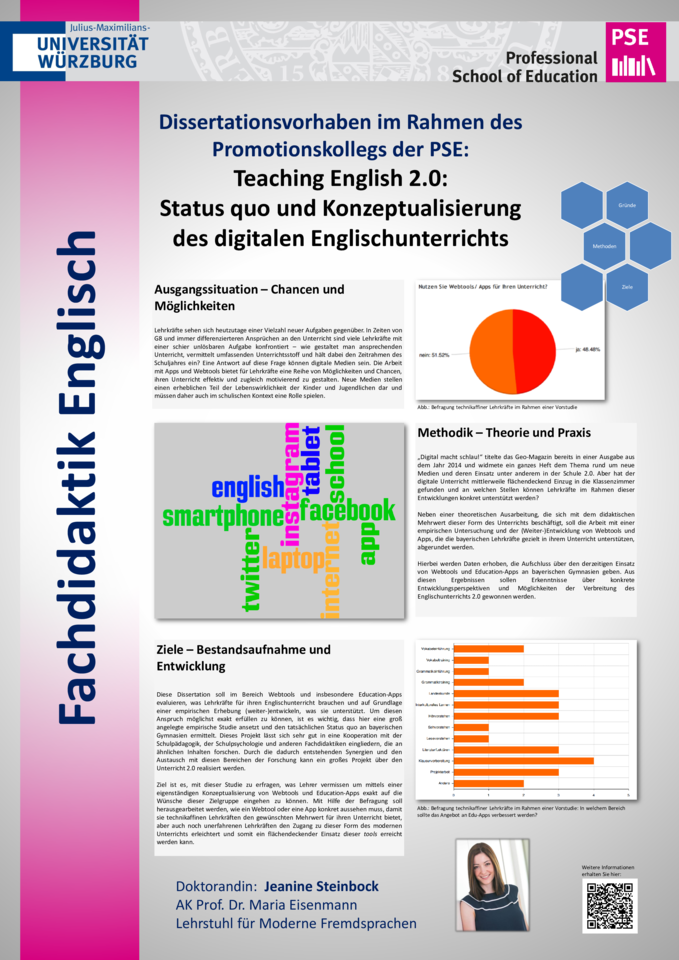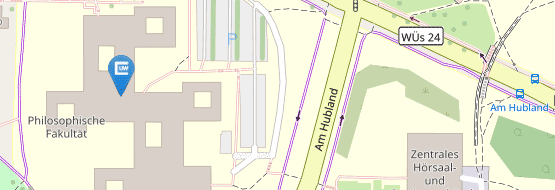Past Events
1. TEFL Day 2016: "Lernerautonomie"
2. TEFL Day 2017: "Media in the EFL Classroom"
3. TEFL Day 2018: "Young Adult Literature in the EFL Classroom"
4. TEFL Day 2019: "Multilingualism in the EFL Classroom"
5. TEFL Day 2020: "Environmental Learning in the EFL Classroom"
6. TEFL Day 2021: "Mental health in foreign language education"
11/29/2017
Tagung für Lehrende und Shakespeare-Freunde am 23./24. November 2017 im Burkardushaus in Würzburg
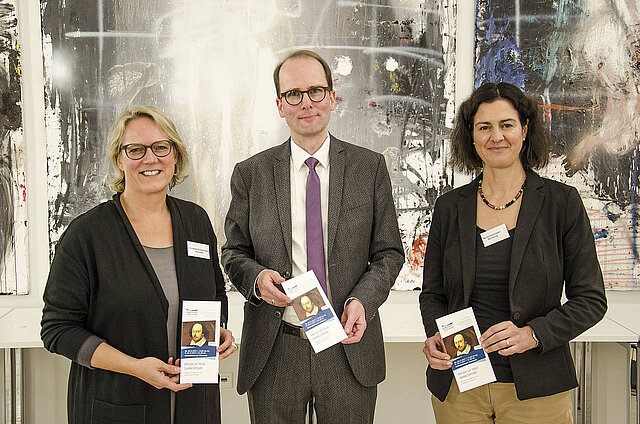
v.l.n.r.: Dr. Vanessa Schormann (Deutsche Shakespeare-Gesellschaft); Dr. Stefan Meyer-Ahlen (Domschule Würzburg) und Prof. Dr. Maria Eisenmann (Universität Würzburg)
Tagungsbericht Brush up your Shakespeare – Tagung für Lehrende und Shakespeare-Freunde am 23./24. November 2017 im Burkardushaus in Würzburg
Unter dem Motto Brush up your Shakespeare – Tagung für Lehrende und Shakespeare-Freunde fand am 23./24.11.2017 die Shakespeare-Tagung in Kooperation mit der Julius-Maximilians-Universität Würzburg, der Domschule Würzburg und der Deutschen Shakespeare-Gesellschaft statt.
Die Idee zur Ausrichtung dieser Veranstaltung hatten Prof. Dr. Maria Eisenmann (Julius-Maximilians-Universität Würzburg und Vorstandsmitglied der Deutschen Shakespeare-Gesellschaft) und Dr. Vanessa Schormann (Leiterin Shakespeare Globe Zentrum Deutschland und Vorstandsmitglied der Deutschen Shakespeare-Gesellschaft). Das Anliegen war und ist es, die Lücke zwischen literaturwissenschaftlicher Shakespeare-Forschung auf der einen Seite und Shakespeare in der Lehre auf der anderen Seite zu schließen, woraus sich konsequenterweise ein Interesse an der didaktischen Umsetzung von Shakespeares Werk ergibt.
Durch die Domschule Würzburg als Kooperationspartner konnte ein attraktiver Tagungsort angeboten werden und mit Dr. Stefan Meyer-Ahlen (Studienleiter der Domschule Würzburg) hatte das Organisationsteam eine tatkräftige Unterstützung vor Ort. Die über 80 Teilnehmer setzten sich gleichermaßen aus Englischlehrenden an Schulen und Hochschulen, Referendaren und Studierenden aller Schularten sowie Mitgliedern der Deutschen Shakespeare-Gesellschaft zusammen.
Die Tagung verfolgte das Ziel, neue interdisziplinäre Einblicke in verschiedene aktuelle Themen und Ansätze der Lehre Shakespeares im (Hoch-)Schulunterricht zu ermöglichen. Der Fokus lag auf der Verbindung von Theorie und Praxis, um so Studierenden, Wissenschaftler/innen und auch Lehrer/innen grundlegendes Wissen im Bereich der heutigen Shakespeare-Rezeption sowie praktische Beispiele, die sich in verschiedenen Unterrichtssituationen bewährt haben, zu vermitteln. In Vorträgen und Workshops wurden anhand einer Vielzahl von Shakespeare-Texten u.a. analytische, kreative und performative Ansätze vorgestellt, moderne und innovative Methoden der Shakespeare-Didaktik dargelegt und kritisch diskutiert. Gerade auch vor dem Hintergrund in jüngster Zeit radikal veränderten medialen sowie literatur- und kulturwissenschaftlichen Bedingungen setzte sich die Tagung darüber hinaus mit der didaktischen Implementierung Shakespeares Werk in der Lehre auseinander.
Patrick Spottiswoode (Director Globe Education, London), bot mit seinem lehrreichen wie unterhaltenden Programm "Space for Play: Shakespeare, Classroom and Playhouse" einen beeindruckenden Auftakt zur Tagung. Im Anschluss luden der Schauspieler Norbert Kentrup, der Musiker Florian Schwarz und die Dramaturgin Vanessa Schormann vom Theater Shakespeare & Partner in Berlin die Tagungsteilnehmer zu einer „wissensreich-theatral-musikalischen Unterhaltung“ zu Shakespeares Unsterblichkeit mit dem Titel „Kämpfen.Sterben.Auferstehen.“ ein.
Als Referent/innen für die wissenschaftlichen Vorträge warenProf. Dr. Rüdiger Ahrens, Dr. Roland Petersohn, Prof. Dr. Laurenz Volkmann, Dr. Theresa Summer, Prof. Dr. Isabel Karremann, Prof. Dr. Christiane Lütge, Dr. Christian Ludwig, Prof. Dr. Frank Erik Pointner, Dr. Jessica Nowoczien und Dr. Jan Eschbach geladen. Neben den informativen und kreativen Vorträgen wurde ein Shakespeare-Impro-Workshop von Florian Schwarz (Impressario, München) angeboten. Parallel dazu gab Prof. Dr. Frank Zipfel (Gastdramaturg am Mainfranken Theater Würzburg) einen Einblick in die Inszenierung von Shakespeares Was ihr wollt in der Regie von Sigrid Herzog, die die Tagungsteilnehmer im Mainfranken Theater Würzburg am gleichen Abend besuchten.
Zu einer besonders anregenden Diskussion kam es in dem, den Abschluss der Tagung bildenden, Podiumsgespräch zum Stellenwert Shakespeares im heutigen Englischunterricht. Ein Schwerpunkt der Diskussion war die Frage, wie Lehrende mit den in den letzten Jahren stark veränderten Lehrplänen in Bezug auf Shakespeare und seinem Werk umgehen. Shakespeare hat inzwischen einen geringeren Stellenwert als noch vor zehn Jahren. Laut Lehrplänen ist es oftmals nicht mehr erforderlich ein ganzes Shakespeare-Drama zu lesen, die Lektüre wird durch das Anschauen von Filmausschnitten oder der Auseinandersetzung mit Adaptionen ersetzt. Shakespeare kann demnach auch nur noch in ‚bits and pieces‘ vermittelt werden.
Friedrich Frenzel, Fachreferent Englisch für die Gymnasien in Unterfranken sieht in den Kürzungen des Lehrplans keine gravierenden Probleme. Shakespeare wird immerhin als einziger Autor noch genannt. Seiner Ansicht nach sieht der Lehrplan nur ein Minimum vor und jeder Lehrende kann nach eigenem Interesse und eigener Motivation handeln und mehr unterrichten als der Lehrplan vorgibt. Dies wurde kontrovers diskutiert und die Reaktionen im Publikum zeigten, dass von Seiten der Lehrenden hier kein Konsens besteht. Kritisiert wurde vor allem die mangelhafte Lehrerausbildung im Fach Englisch bezüglich Shakespeare und seinem Werk. An vielen Universitäten können zahlreiche Kurse zur Kultur-, Literatur- und Sprachwissenschaft belegt werden ohne Shakespeare-Kenntnisse zu erlangen. Fehlen diese aber, ist eine zukünftige Vermittlung seines Werks, auch hinsichtlich elementarer kultureller und literarischer Bildung, die ja in der Schule vermittelt werden soll, nicht möglich. Prof. Dr. Christiane Lütge (LMU München) sprach sich gegen eine Kanonisierung seines Werkes aus, sieht es aber als sinnvoll an, Shakespeare wieder für alle Studierende im Fach Englisch verpflichtend einzuführen. Auch für Prof. Dr. Laurenz Volkmann (Universität Jena) ist es unumgänglich, Originaltexte an den Universitäten zu lesen.
Bezüglich der Vermittlung von Shakespeares Werk im Schulunterricht steht die Frage, was vermittelt werden soll: die der Handlung zu Grunde liegenden Geschichten, die komplexe, bildreiche Sprache oder das Theaterspezifische eines Dramentextes. Je nachdem sind jeweils andere didaktische Methoden erforderlich. Dr. Jessica Nowoczien, Lehrerin und Mitarbeiterin an der Universität in Lüneburg, plädierte, dass die zu vermittelnden Inhalte den Interessen der Schülerinnen und Schüler angepasst werden sollten und ermutigte die Lehrenden, die Vielzahl an unterschiedlichen Herangehensweisen zu nutzen.
Kontrovers wurde die Frage diskutiert, ob Shakespeare in der Schule im Original gelesen werden sollte. Befürworter der Dramenlektüre im Original standen denjenigen gegenüber, die in der Rezeption von Adaptionen und Bearbeitungen, wie z.B. Graphic Novels, Filme, Comics usw. einen Vorteil für Schüler sehen. Dr. Christian Ludwig (PH Karlsruhe) stellte dazu fest, dass aber auch Adaptionen nur verstanden werden können, wenn den Lehrenden zuvor das Original bekannt ist. Tagungsteilnehmer berichteten über ihre Erfahrung, dass Schüler oftmals trotz aller „ShakesFear“ die Stücke komplett und im Original lesen wollen. Dr. Jan Eschbach, Lehrer aus Neuss, betonte, dass Schüler nicht bevormundet werden sollten, indem man ihnen Shakespeare vorenthalte. Lehrende sollten sich der Herausforderung stellen, Schüler auch mal zu „überfordern“.
Die Tagungsteilnehmer bekräftigten am Ende der Diskussion nochmals den Appell, Shakespeare in der (Hoch)Schullehre wieder stärker zu verankern. Hochschullehrende der englischen Literaturwissenschaften und Englischen Fachdidaktik, aber auch die Deutsche Shakespeare-Gesellschaft sollten sich diesbezüglich ihrer Verantwortung bewusst sein und dementsprechend den kommunikativen Austausch mit den Verantwortlichen in der Kultur- und Schulpolitik suchen.
Die Resonanz der Teilnehmer/innen sowie der Referent/innen auf das abwechslungsreiche und informative Tagungsprogramm war insgesamt sehr positiv. Auch aus Sicht der Ausrichter der Tagung war die Veranstaltung ein voller Erfolg – ein praxisorientierter, anregender Austausch auf allen Ebenen. Aufgrund des überwältigenden Interesses und der enorm großen Nachfrage an diesem Tagungsformat sehen sich die Kooperationspartner bestätigt, dieses auch weiterhin in regelmäßiger Form fortzusetzen.
Maria Eisenmann & Vanessa Schormann
11.11.2017
Am 11.11.2017 fand an der Universität Würzburg die feierliche Eröffnung der Professional School of Education (kurz: PSE) statt.
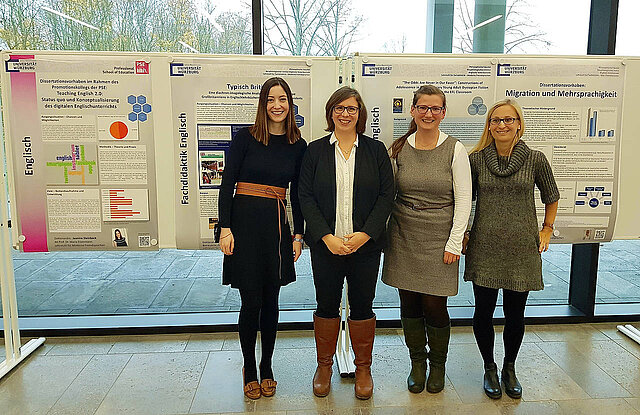
Doktorandinnen des Lehrstuhls für Englische Fachdidaktik (von links nach rechts): Jeanine Steinbock, Jennifer Meier, Nadine Krüger und Elisabeth Chowanetz
Die PSE ist eine Weiterentwicklung des Zentrums für Lehrerbildung und steht Lehramtsstudierenden mit Rat und Tat zur Seite, wenn es beispielsweise um einen Auslandsaufenthalt oder Praktika (Lehrwerkstatt) geht. Neu ist ein großangelegtes Forschungsprojekt zum Thema "digitale Medien", in das mehrere Fachdidaktiken, sowie die Schulpädagogik und die Schulpsychologie eingegliedert sind. Wir freuen uns, Teil dieses Forschungsprojektes zu sein und gemeinsam mit den anderen Disziplinen auf diesem Gebiet zu forschen.
26.06.2017
In summer 2017, a very outstanding experience took place for future English teachers from the University of Wuerzburg as well as the University of Augsburg.

© Selina Rüb
The Irish Experience: Excursion from 26 June to 01 July 2017
In summer 2017, a very outstanding experience took place for future English teachers from the University of Wuerzburg as well as the University of Augsburg. While seminars on how to teach English to students usually focus on theoretical aspects, we had the chance to combine the theory of planning a class trip with the actual experience abroad and the implementation of what had been planned before. 14 students from the University of Wuerzburg, together with Prof. Dr. Maria Eisenmann, and 11 students from the University of Augsburg, together with Prof. Dr. Engelbert Thaler, wanted to experience Ireland and its culture. Dr. Ina Bergmann, University of Wuerzburg, also accompanied us. With her connections to Trinity College in Dublin and University of Galway, and her friendly and welcoming attitude, her participation on the trip was an enrichment for us all. The trip was planned by each university in seminars beforehand. We were divided into groups with different responsibilities and each group had a corresponding “partner group” from the other university. One group was responsible for history, one for museums, one for culture, one for Trinity College, one for geography and one for Irish writers. The framework of the trip was already given (Dublin and Galway), but we had to fill it with life. We therefore researched, planned, booked and prepared the presentations for abroad. As the purpose of this excursion was not only show us what to do with students in Ireland, but also how to do it, one part of our presentations was to think about the didactic implementation of the content in- and outside the classroom. By the end of June we were all set for Ireland. How exciting to soon meet the students from the other university for the first time!
MONDAY: After arriving separately in Dublin, we all met at the Harcourt Hotel in Harcourt Street between 1 and 2 pm. The sooner one arrived, the more time one had for a good Irish Coffee! Good start for a good trip. As soon as everyone had arrived, we set out for our first walk around the town, led by the group responsible for history. The first stop was St Stephen’s Green, a park area quite close to our hotel at the end of Grafton Street. At each stop there was a short presentation on the facts and stories about each destination. Just the way one could do it with students! The next stop was Dublin Castle – built in the 13th century, it nowadays holds some of the government departments. As we had many stops on our agenda, we hurried on to Christ Church, also known as The Cathedral of the Holy Trinity. It is one of Dublin’s eldest medieval cathedrals, next to St Patrick’s Cathedral. Off we went from there on to the Temple Bar area with the Temple Bar itself, probably the most famous pub in Dublin, and all its other pubs around. During the day there is not too much going on there, apart from the tourists running after a few good pictures of this well-known place, but at night Temple Bar is full of people partying and trying to experience the Irish pub culture. But always keep in mind: when going there with students, it is important to think of the additional benefit such a visit to a pub could have. Quite close to the Temple Bar area, in Grafton Street, there is the statue of Molly Malone – a well-known figure in Dublin, and to foreigners also known thanks to the song by The Dubliners: “In Dublin's fair city, where the girls are so pretty, I first set my eyes on sweet Molly Malone. As she wheeled her wheel-barrow, through streets broad and narrow, crying ‘Cockles and mussels, alive, alive, oh!’”. It is not known whether the fictional character Molly Malone is based on the life of a real woman or not. Legend has it that Molly Malone was a fishmonger, who also worked as a part-time prostitute. It is said that she died very young of a fever. The statue is a tourist attraction and many tourists passing by grab Molly Malone’s bosom for luck, so that one can see the bronze wearing off there. So far we had only been on the south side of the River Liffey. It divides Dublin into two parts, but there are multiple beautiful bridges between the two parts of the city. Our next stop should have been the so-called GPO (General Post Office), headquarter of the rebels during the Easter Rising of 1916 and therefore an important site for the history of the Republic of Ireland. But the GPO lies in O’Connell Street on the north side of the town. As we had already walked a lot and were quite hungry, we decided to skip that stop and look for a nice pub instead to grab some Irish food and drink a pint of Guinness. We still had two days to go in Dublin!
TUESDAY: After a rather heavy Irish Breakfast with sausages, bacon and scrambled eggs, we set off quite early for the destination of this morning: Trinity College Dublin. Famous people once studied there, including Oscar Wilde and Samuel Beckett. First, we went to one of the modern buildings on the campus, just next to the Library with the famous Book of Kells. In the Trinity Long Room Hub Arts & Humanities Research Institute, we were welcomed by Dr. Caitriona Curtis, the Institute Manager. She explained the tasks of the institute to us: “The Trinity Long Room Hub offers a world-class research environment that harnesses and expands the excellence of Trinity’s Arts and Humanities research by pioneering and facilitating cross-disciplinary collaborative projects." She also showed us around the highly modern building, built in 2010, that received many prizes for its architecture. In one of the rooms, where researchers usually meet for presentations and conversations, we were allowed to have a presentation about the history of Trinity College and its faculties, as well as the Book of Kells. After some refreshments, we went next door to the Library with the famous Book of Kells. The Book of Kells is an old Gospel book written in Latin and probably created around 800 AD. It contains the four Gospels of the New Testament and is illustrated with many pictures. Unfortunately, one can only see one page at a time, as it is kept in a glass case. Passing through the room with the Book of Kells and up the stairs one can stroll down the Old Library – what a sight! A very high ceiling, shelves on both sides of the long room and statues of important philosophers and writers on both sides…and books, books, books! We were amazed - so many books in such a wonderful place! We saw some German pupils running around with handouts – and immediately thought of the options we would have to bring this place closer to students through different tasks. The idea of this trip was obviously working! But once again we still had many things to do and see. After a short tour around the campus and some food and drinks, we set off to the Tara Train Station to get the train to Dalkey, which is a lovely little village half-an-hour drive away from Dublin next to the sea. After having rushed through Dublin City, it was nice to escape the hectic city life and enjoy the more rural landscape and some quiet time. And the landscape outside Dublin is outstanding! We walked through Dalkey in the direction of Killiney. There are beautiful houses on the hill, with a great view over Dublin Bay and of course the Irish Sea. It felt Mediterranean, especially because the sun was shining and therefore the wind did not seem so cold anymore. Some brave students even jumped into the cold water, celebrating the ‘Irish summer’. Up the hill we went towards Killiney Hill Park and the Killiney Obelisk. Especially towards the end the path got very steep – we were happy to arrive at the top of the hill. The view was breathtaking! Just before the Killiney Obelisk, there was a ‘wishing pyramid’. Of course we didn’t miss the chance to walk up to the top in circles, while looking towards Dublin and making a wish with our eyes closed as soon as we arrived on the top. Dr. Bergmann obviously had a good time taking a video of the line of students climbing up the pyramid. It was much fun! The Killiney Obelisk was built in commemoration of the ‘forgotten famine’ of 1740/1741 due to an exceptionally cold winter. After a short rest, we continued our way down to the village of Killiney to take the train back to Dublin. We were all quite exhausted but very happy to have done this walk.
WEDNESDAY: In the morning we checked out of our hotel and once again made our way to the city. Topic of this morning: Irish writers. Originally, five stops were included in the tour: St. Patrick’s Cathedral with the Grave of Jonathan Swift, the Cú Chulainn statue in the General Post Office, the James Joyce Statue and Mulligan’s Pub, as well as the Oscar Wilde Memorial. However, because it was a very rainy day, we only managed to walk to St. Patrick’s Cathedral, where we listened to student presentations on both Saint Patrick and Jonathan Swift, whose grave is inside the cathedral. From there, across the River Liffey and down O’Connell Street, we walked to the General Post Office. Inside the GPO there is a statue of Cú Chulainn, is a very important figure both for Irish identity, as well as for William Butler Yeats. We heard a presentation about William Butler Yeats and one of his poems there. Furthermore, another presentation on the Easter Rising, originally scheduled for Monday, was then given in the GPO as well and illustrated quite nicely how history is always intertwined with culture and reflected in literature and arts in general. After those stops, we walked past the James Joyce statue. However, we didn’t linger there due to the heavy rain, but went straight to the National Museum of Ireland: Archaeology and did that part of our agenda first. In the Museum, we learnt a great deal about Medieval Ireland (1150-1550) and Viking Ireland presented in a very illustrative way, which was both very enlightening and interesting. As to the literary walking tour: the two missing presentations about James Joyce and Oscar Wilde were then given in a dry spot in front of the museum and back in the warm and cosy hotel lobby. In the afternoon, we collected our luggage at the hotel and took the bus to Heuston Station, from where we took the train to Galway. Many of us had an extended nap on the train – sightseeing during the day, much information to take in and not forgetting a pint or two of Guinness every night had made everyone tired. Three hours later we got off the train in Galway and made our way to the hostel by foot. Sleepzone – the name of the hostel was very welcoming to us! Food, drinks, a bit of rest: at 7 pm half of our group met to go to a musical called Misé Éire – I am Ireland at the Black Box Theatre Galway. After a short introduction to some famous Irish tales and legends, we dived into a very special “Irish Experience”: accompanied by fiddle, harp, Irish flute and step dancers, we could emerge into the Irish history from the pre-Christian times till the Proclamation of the Republic of Ireland. From Grace O’Malley, the “Sea Queen of Connacht”, to the story of how Cú Chulainn, an Irish hero and warrior of the pre-Christian time, got his name (meaning “Hound of Chulainn”); from the story about the Claddagh Ring (a well-known symbol that stands for love, friendship and loyalty) to the Great Famine and the Emigration to the New World in the middle of the 19th century; and from there to the Easter Rising of 1916, the Proclamation of the Republic and finally, Ireland’s independence from the United Kingdom. The musical showed the pride of the Irish in their country and their culture. We all enjoyed the musical very much as it summarized many of the places and stories we had seen and heard the days before in Dublin. We decided that it would be worthwhile to take students there as well – provided with the right tasks, they could learn much about history and culture in a very entertaining environment. THURSDAY: It was time for nature and the coast again. We had a private coach plus driver who took us through the great scenery of the Connemara National Park. Our tour started in Galway at 10 am. Connemara is an area located on the western coast of Ireland where the Irish language is predominately spoken. The rural area has an incredible landscape to offer. We were overwhelmed by the diversity of hidden lakes, mountain ranges, wide beaches and rocky ground. First stop was Kylemore Abbey, a castle reminding us of fairy tales. It is located next to a small lake and has a beautiful Victorian walled garden. Afterwards we drove to a quaint little fishing village to get lunch there. It was windy and cold outside, but this fact did not bother us anymore after a few days in Ireland! We continued our journey after an hour, as we still had quite a few kilometres to go on small and bumpy roads. On the way we got the chance to see more of the beautiful shore of the Atlantic Ocean. After a while we stopped again at a breath-taking beach to dip our feet in the water and to take more pictures. But the sky was very cloudy and from time to time it rained, so we decided to drive back to Galway. In the evening, before we set out for our pub crawl, we had a little practical activity outside our hostel. We danced an Irish folk dance called Bridge of Athlone. Everyone had to choose a partner and then we lined up, men facing women. And off we went! Forward, two, three, bow; back, two, three, four. Swing your partner with the right arm, swing your partner with the left arm. And then the first couple dances down the aisle! And back up again! And everyone follows, the first couple makes a bridge, and everyone passes through into their new position. And repeat from the start! Forward, two, three, bow…after five minutes of dancing and laughing and stepping on each other’s feet from time to time everyone was exhausted, but one couldn’t see a face without a smile on it. Dancing is freeing up emotions and bringing cultures together in a unique way. After the dance, we went to a few pubs in Galway. On the bus and back in the hostel we had heard presentations about Irish Traditional Music, also called Trad Music. As Galway is a very touristic place, one can find many pubs offering live music every night. But it was hard to find a pub with space for around thirty people, so the group soon split and everyone went on their own pub crawl. Some of us went to a pub called O’Connor’s, where Ed Sheeran shot part of the video to his famous song Galway Girl: “She played the fiddle in an Irish band, but she fell in love with an English man…” It was a good night out!
FRIDAY: In the morning we headed out for a Galway city tour. Not only did we just walk around the beautiful town, we also grouped up and tried to answer all the questions of a rally that was especially made up for the tour around Galway. We started at Eyre Square, a small park area close to our hostel. It is also known as John F. Kennedy Memorial Park, as the president of the United States gave a speech there during a trip through Europe. Walking down the pedestrian zone with its little shops and street musicians we passed Lynch’s Castle, a medieval limestone building. It was home to the Lynch family, one of the most powerful families of the area at that time. Afterwards we stopped at St Nicholas church. Legend says that Christopher Columbus once worshipped there. Following the direction of the coast we reached the Galway City Museum that provided us with additional information about Galway and its past. Next to the Museum one can still see the Spanish Arch which is part of the old wall around the town and is known as a former fish market place. Passing the river Corrib we reached the Claddagh, which means “stony beach” in Gaelic. It is one of the oldest former fishing villages in Ireland and records go back to the arrival of Christianity in Ireland in the 5th century. During the Great Famine, many of its inhabitants left, especially the young men. Next stop: Nora Barnacle house – the place where James Joyce’s wife grew up. Unfortunately, the little museum inside was closed that day. Further on we walked over the Salmon Weir Bridge and came to the Galway Cathedral. Time for some lunch! An hour later we all met again at the Cathedral – those of us who had been there earlier even watched an Irish wedding taking place there! Our last stop was the National University of Ireland, Galway, where we got the chance to listen to Dr. Erin A. McCarthy as she explained her research project RECIRC: The Reception & Circulation of Early Modern Women's Writing, 1550-1700: “RECIRC is producing a large-scale, quantitative analysis of the reception and circulation of women's writing from 1550 to 1700. The results will enable analysis of how texts, ideas and reputations gained traction in the early modern period." Dr. McCarthy is one of ten female researchers concerned with this project. After showing us around the mosrn campus, Dr. McCarthy led us to the oldest part of the university, the historical Quadrangle Building from 1849. The sun was shining, some students lay on the grass reading a book – the University of Galway seems like a very good place for studying!
As it was our last evening, we decided to have dinner together at the famous “King’s Head” pub restaurant. Irish food and once again a pint of Guinness – a decent end for a very informative and enriching trip! All in all, the participants in this excursion got along very well, which contributed to an utterly pleasant and learning-friendly social environment, beneficiary for everyone: Thanks to the informative presentations prepared by the students and the outstanding organizational contributions by Dr. Bergmann and, most notably, Prof. Dr. Eisenmann, we learned a fair deal about life on the Emerald Isle: We became acquainted with its culture, literature, music, language, history and the geography of both its rural and urban areas. The knowledge gained in the seminar and during the excursion forms the basis of one day planning a class trip to Ireland ourselves. In the name of the group, we would like to thank everybody who made The Irish Experience as stunning and unforgettable as it was!
Michelle Zirkel, Lisa Jaretzke, Deborah Klein



